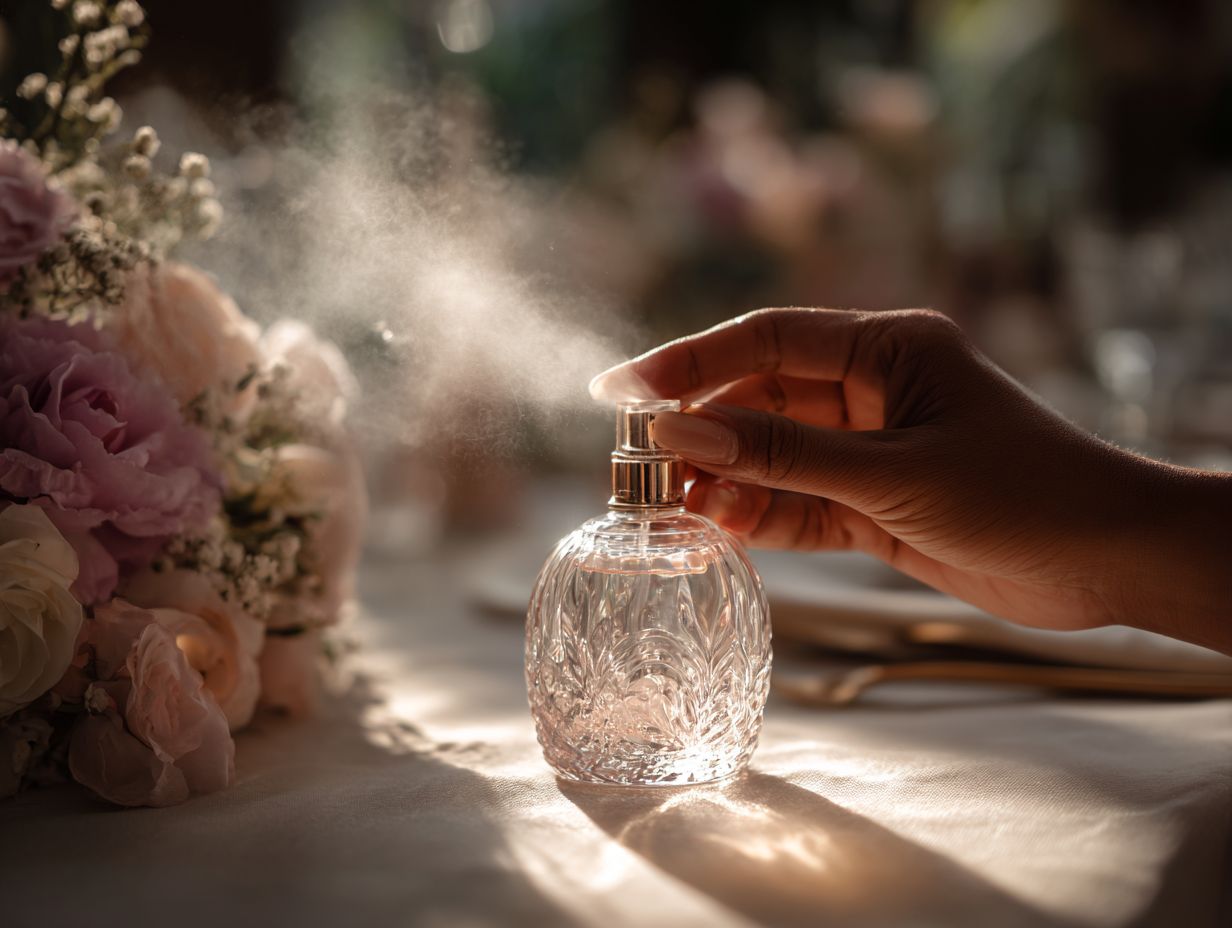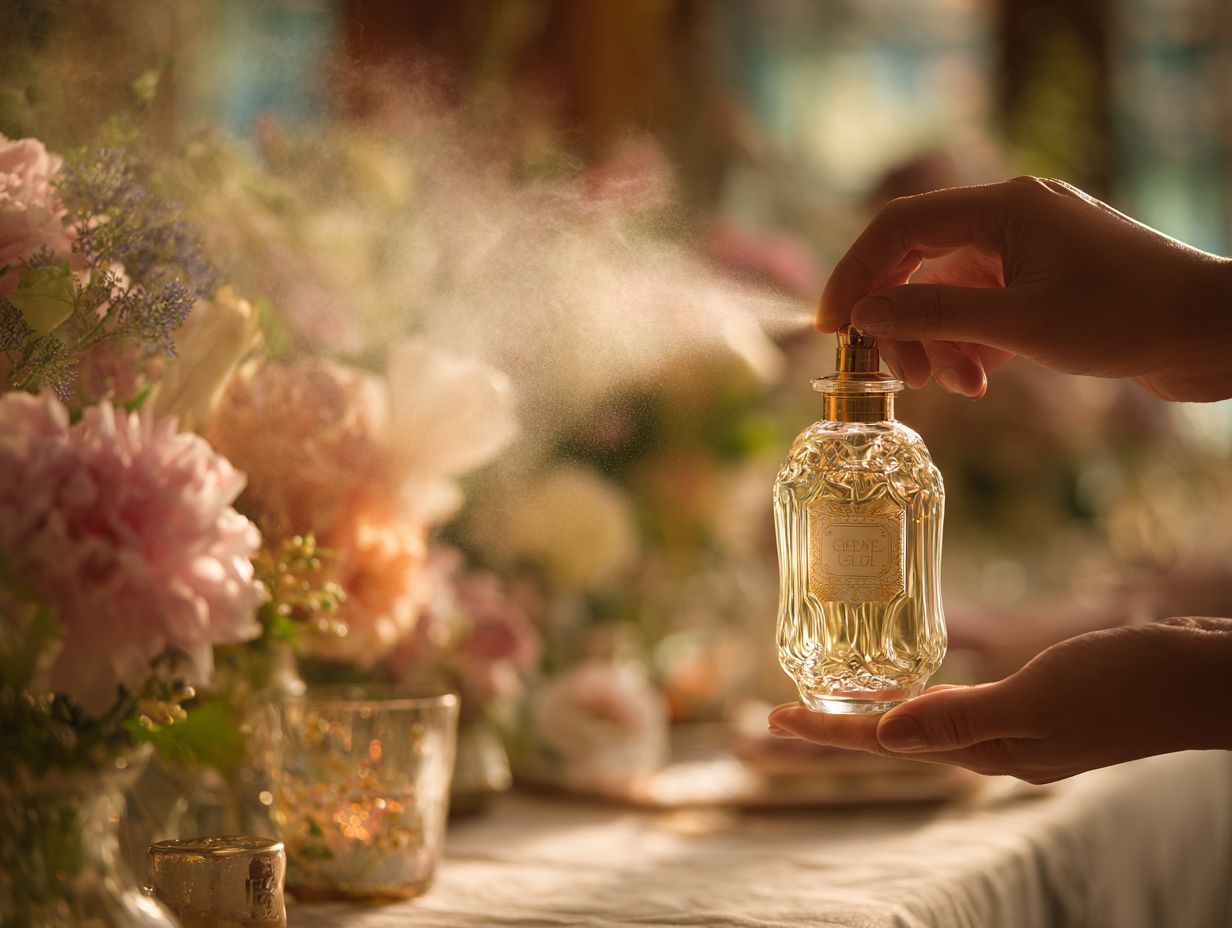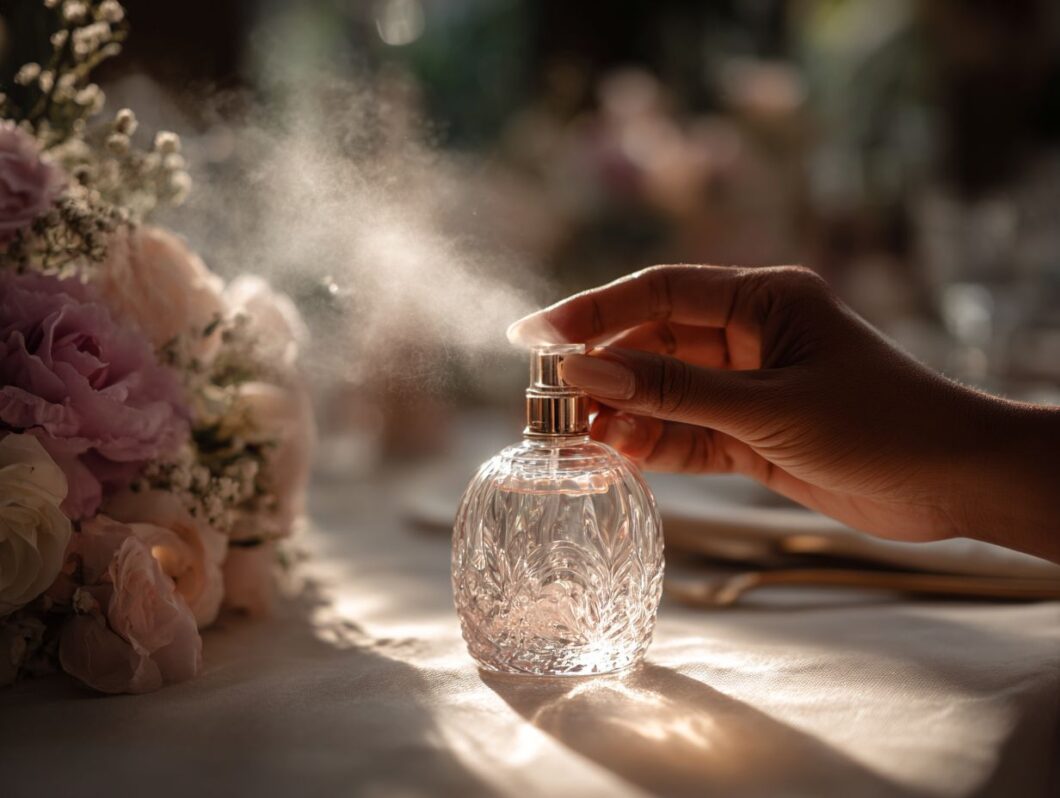The scent that envelops you can be as telling as your attire. As someone who appreciates the art of fragrance, I’ve realized that perfume etiquette is crucial for making a lasting impression. Understanding the nuances of when, where, and how much to spray can elevate your olfactory experience. In this exploration, I’ll delve into fragrance types, ideal application times, effective spots to spritz, and common pitfalls to avoid. Join me in mastering the delicate balance of scent sophistication.
Understanding Fragrance Types

I understand that fragrance types can be categorized into several types, each influencing their fragrance strength, perfume longevity, and ideal use cases.
Perfume Concentrations
Perfume concentrations vary significantly, encompassing options such as Eau de Toilette (5-15% concentration) and Eau de Parfum (15-20%), each providing different fragrance strengths and durations. Understanding these concentrations is essential for enhancing my fragrance selection.
Eau de Toilette typically lasts around 3-5 hours, making it ideal for casual or daytime wear. In contrast, Eau de Parfum has a longevity of 4-8 hours and is better suited for evening or formal occasions.
For example, Chanel No. 5 is a renowned Eau de Parfum, while Dolce & Gabbana Light Blue serves as an excellent representation of a popular Eau de Toilette.
Ultimately, I consider my daily schedule, personal grooming, and preferred scent intensity when choosing between these options.
Notes and Their Significance
A fragrance’s complexity lies in its carefully crafted notes: the top notes provide the initial impression, the middle notes form the essence, and the base notes lend depth and longevity.
For instance, consider Chanel No. 5, a signature scent. Its top notes feature vibrant citrus and aldehydes, delivering a bright and fresh introduction. As the fragrance settles, the middle notes of jasmine and rose emerge, imparting a floral richness that is both classic and timeless.
Finally, the base notes of sandalwood and vanilla establish a warm, lasting foundation that anchors the entire composition.
Over time, I observe that a fragrance evolves, revealing its intricate layers and depth. This transformation makes the initial encounter merely a glimpse into its full character. By understanding this evolution, I can enhance my appreciation for different perfumes and the artistry behind them.
When to Wear Perfume
I understand that selecting the appropriate time to wear perfume can greatly enhance my fragrance experience and improve my social interactions.
Day vs. Night Applications
Daytime fragrances tend to be lighter and fresher, often incorporating citrus or floral notes, while evening perfumes typically exhibit deeper, more intense aromas.
For daytime fragrance options, I recommend:
- Giovanni’s Light Citrus ($45) for its invigorating blend of lemon and bergamot,
- Marc Jacobs Daisy ($100), which artfully combines wild strawberries with sweet violet.
As the day transitions into evening, I suggest switching to a fragrance like:
- Tom Ford Noir ($150), which masterfully blends spicy and woody notes,
- Yves Saint Laurent Black Opium ($120), known for its rich coffee and vanilla profile.
To make the transition seamless, I apply a lighter daytime scent to my pulse points. As evening approaches, I enhance my presence by applying a few drops of a more robust fragrance to my wrists and neck, ensuring a lasting impression.
Seasonal Considerations

Different seasons require distinct fragrance families, and I believe that lighter scents are particularly suited for warm weather, while richer, spicier scents excel during the cooler months.
During spring and summer, I prefer seasonal perfumes with citrus scents such as lemon and bergamot, or floral scents like jasmine and peony. These fragrances are light and refreshing, making them ideal choices for higher temperatures.
Conversely, as fall and winter approach, I find that richer scents like sandalwood and amber, along with spices such as cinnamon and clove, provide the warmth and depth that the season calls for.
I have observed that the climate significantly influences scent perception; warmer temperatures can amplify fragrance intensity, causing fresher scents to feel more invigorating. Meanwhile, darker fragrances tend to linger longer in the cooler air, creating a captivating experience.
Where to Apply Perfume: Pulse Points and Beyond
The location of perfume application significantly influences how the scent is perceived by others and its longevity.
Pulse Points Explained
I find that perfume is most effectively applied to pulse points, as the body heat in these areas helps to diffuse and enhance the fragrance.
The primary pulse points I focus on include the wrists, neck, behind the ears, and the inner elbows.
To apply the perfume effectively, I lightly spray or dab it on these areas, making sure to avoid rubbing, as this can alter the scent. For a balanced distribution, I typically use a single spritz on my wrists and neck.
It’s important to be mindful of the amount I apply in sensitive areas; usually, one spray per pulse point is sufficient to respect personal space and avoid perfume overspray. This approach not only enhances the longevity of the fragrance but also leaves a subtle, pleasant trail without overwhelming those around me.
Other Application Areas
Along with applying perfume to pulse points, I find that misting it onto my hair or clothing can create a lasting scent that is subtle and not overpowering for those around me. For optimal results, I lightly mist my clothing from a distance of about 6-8 inches to avoid oversaturation.
Alternatively, I prefer applying perfume to my hair by spritzing it onto a brush before combing through, which prevents direct contact and reduces the risk of staining. I also choose lighter, alcohol-free scents to minimize any potential residue.
I enjoy experimenting with scent layering and layering complementary scents-combining a floral fragrance on my clothing with musky, warm fragrances in my hair allows me to create a unique olfactory profile while maintaining a subtle presence.
How Much to Spray
I recognize that understanding the appropriate amount to spray can significantly impact the overall scent experience, determining whether it is pleasant or overwhelming.
General Guidelines

I follow general guidelines that suggest applying 2-4 spritzes of fragrance for daily wear, adjusting as needed based on the concentration and the occasion.
For lighter fragrances, such as colognes or eau de toilettes, I find that 2-3 spritzes work effectively. However, for more concentrated perfumes, like parfum or extrait de parfum, I prefer to limit myself to 1-2 spritzes to avoid overpowering myself or those around me.
To assess the strength of a fragrance before applying it, I spray a small amount on a test strip or my wrist and wait a few minutes to avoid overwhelming those in fragrance free environments. This allows the scent to develop fully, enabling me to determine whether it aligns with my preferences for the occasion.
Adjusting for Different Occasions
For formal events, I find it effective to limit fragrance application to 1-2 sprays to maintain a sense of subtlety. In contrast, casual gatherings allow for a more generous application.
In workplace fragrance settings, I prefer clean and professional scents, such as light citrus or crisp floral notes, which are refreshing and non-intrusive. In terms of social outings, I enjoy experimenting with warmer fragrances like vanilla or sandalwood, which add a touch of personality.
For intimate gatherings, I opt for deeper, more alluring scents like amber or jasmine, applying 2-3 sprays to create a captivating atmosphere. It’s also essential for me to test how a scent evolves on my skin, as body chemistry can significantly alter the fragrance.
Common Mistakes to Avoid
Being aware of common perfume mistakes allows me to maintain an enjoyable scent experience for both myself and those around me.
Over-spraying and Other Etiquette Rules
Over-spraying can create overwhelming scent clouds that may be unpleasant to those around me, often resulting in negative perceptions. To avoid this mistake, I apply fragrance in stages. I begin with a small amount on pulse points, such as my wrists and neck, and allow it to settle for a few minutes to assess the fragrance’s intensity before deciding if more is needed.
Testing scents in-store is also beneficial; I prefer to spray on a blotter or my skin beforehand to observe how the fragrance develops over time. It’s important to remember that it’s much easier to add more fragrance than to remove excess. As a general guideline, I aim to use two to four sprays, depending on the strength of the scent.
Mixing Fragrances
Mixing different fragrance families can result in dissonant scent profiles that clash rather than complement one another. To create harmonious scent blends, I start by identifying compatible fragrance families. For instance, pairing floral scents like jasmine with citrus fragrances such as bergamot can yield an uplifting and balanced aroma.
Alternatively, I find that vanilla-based scents can soften the sharpness of spicy notes like sandalwood, resulting in a warm and inviting fragrance.
I prefer to use an oil diffuser for experimentation; I begin with a few drops of each fragrance and adjust based on my preferences. Ultimately, I’ve learned that less is often more; a light touch ensures a more nuanced and pleasant scent profile.
Frequently Asked Questions

When is the appropriate time to spray perfume?
The best time to spray perfume is after you have completely dressed and before you leave your house, ensuring that your chosen event fragrance lasts throughout the day. This ensures that the perfume will not transfer onto your clothes and that it will last throughout the day.
Where should perfume be sprayed for optimal scent diffusion?
Perfume, especially travel-sized perfume, should be sprayed on pulse points, such as the wrists, neck, and behind the ears. This is where the skin is warmer, enhancing the fragrance diffusion and allowing the scent to develop and last longer, catering to your scent preference.
How much perfume should I spray to avoid olfactory fatigue?
The amount of perfume you should spray depends on the strength of the scent and your personal preference, considering scent sensitivity and social settings. Generally, 1-2 sprays are enough for a lighter scent, while 3-4 sprays may be needed for a stronger scent. It is important to not overdo it, as strong scents can be overwhelming to others, especially in intimate settings.
Should I spray perfume on my clothes or skin to match my skin chemistry?
Perfume is meant to be sprayed on the skin, where it can interact with your skin chemistry, as it reacts with your body’s heat and oils to create a unique scent, contributing to scent memory. Spraying on clothes can cause the scent to be different and may also stain the fabric.
Is it appropriate to reapply perfume throughout the day without triggering fragrance fatigue?
Yes, it is acceptable to reapply perfume throughout the day if needed, especially if using unisex fragrances. However, it is important to not overdo it, as this can lead to olfactory fatigue and be inconsiderate to those with scent allergies around you who may be sensitive to strong scents.
What is the scent etiquette for wearing perfume in public spaces?
When in public spaces, it is important to be considerate of those around you and not to wear a strong or overpowering scent, taking into account cultural norms. It is also polite to avoid spraying perfume directly in common areas, such as elevators or shared office spaces. Instead, use subtle spray techniques on pulse points and allow the scent to naturally diffuse, respecting fragrance etiquette.


